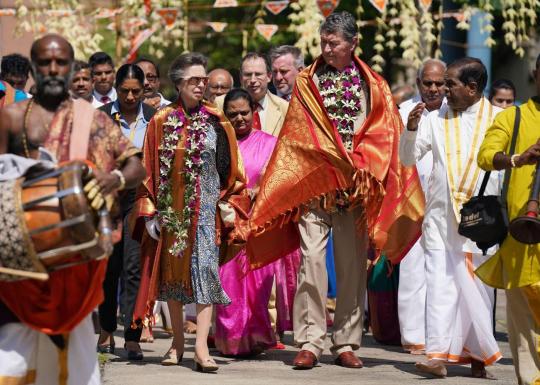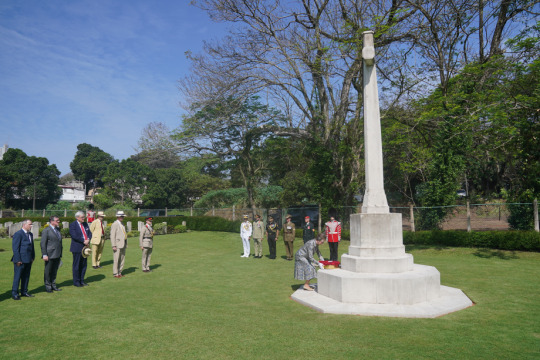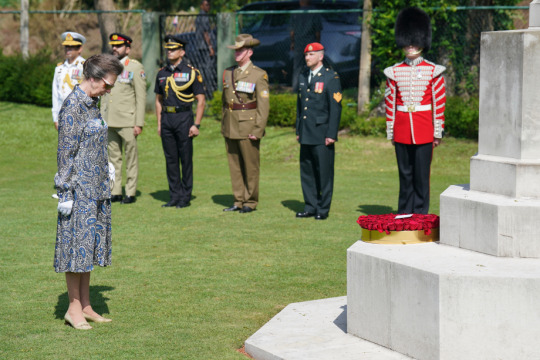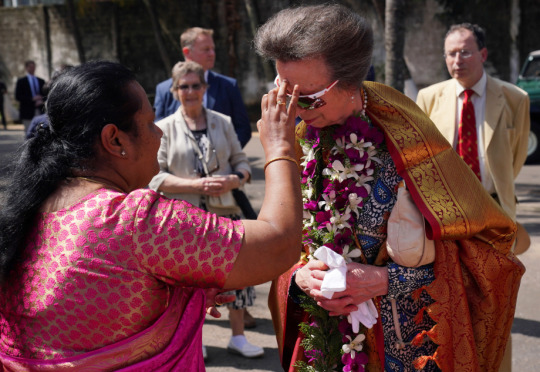#Thorana
Explore tagged Tumblr posts
Text
Thorana wesak Festival in Sri Lanka

2 notes
·
View notes
Text
The Princess Royal and Sir Tim Laurence visit Sri Lanka.

Day 3: Colombo
This morning, The Princess Royal visited her first Commonwealth War Graves Commission (CWGC) Cemetery as their President.

During Remembrance Weekend in November 2023, Buckingham Palace announced that The Princess Royal would become President of the CWGC, taking over from His Royal Highness The Duke of Kent who had been President since 1970. His Majesty The King was also announced as the first Patron of the CWGC.

At the Commission’s Jaawatte Cemetery in Colombo, the largest CWGC site in Sri Lanka, Her Royal Highness was introduced to the Defence Advisor for Sri Lanka and the Maldives’ British High Commission, Colonel Darren Woods who lead a short Service of Remembrance which included an extract from the poem ‘For the Fallen’. A Bugler played the Last Post before a minute’s silence is held. After the Service, Her Royal Highness layed a wreath and viewed some graves, escorted by Colonel Woods.

Next, Her Royal Highness visted Vajira Pillayar Kovil, a Hindu Temple in Colombo. On arrival at the temple, Her Royal Highness and Sir Tim were presented with a garland of jasmine and rose flowers, a silk shawl receive a pottu in the middle of their forehead.

After watching a Hindu Dance Group perform at the entrance of the Temple, The Princess Royal met Chief Priest of Vajira Pillayar Kovil, Sachithanantha Kurukal who conducted a special pooja (blessing). Her Royal Highness also toured the main prayer hall and viewed the shrines.

After visiting the Temple, Her Royal Highness travelled to the British Council to hear about their work in building relationships and connections between UK and Sri Lanka through education, arts and cultural ties. HRH viewed The Arches of Awe exhibition which comprises photographs of the 21 arches that were erected across Colombo to welcome The late Queen Elizabeth II and The late Duke of Edinburgh during their visit to Sri Lanka in 1954. Dating back centuries, similar archways, also known as ‘thoranas’ were found across Asia and were often connected to traditional religious rituals.

The Princess then visited The Mission to Seafarers, an organisation which cares for the welfare of seafarers. The Princess Royal has been its President since 1984. During the visit, HRH toured the recently refurbished Mission to Seafarers centre and opened their new Family Room.

After this The Princess Royal went to Hatch Works’ co-working space to meet a selection of start-up companies, Her Royal Highness attended her final engagement in Sri Lanka, a I Reception, hosted by the British High Commissioner, to mark 75 years of diplomatic relations between the United Kingdom and Sri Lanka. Her Royal Highness ended the visit with a few spoken words about the relationship between the United Kingdom and Sri Lanka.

© Royal UK | 12 January 2024
#BUSY DAY#princess anne#princess royal#tim laurence#timothy laurence#workanne#brf#british royal family
32 notes
·
View notes
Text
storyboarding ideas
Shot - 1 Foreshortened view of candles in eye level This will work as the establishing shot of a festive occasion
shot - 2 Low angle shot of the guests at the wedding I want this shot to show the unfamiliarity of this world to Ganga in the beginning and to also add a sense of mystery to who the guests are, they are in fact prostitutes of the brothel.
Shot- 3 Low angle shot of Gangubai walking down the aisle with her parents, To obstruct Gangu's face at first
and to show the upside of the thorana she is under Rule of thirds for Ganga's placement
Shot - 4
Closeup shot of Ganga's face Estabilishing shot Shot- 5
Rule of thirds Eye level Establishing shot for the groom Shot - 6 High Angle shot of Ganga walking to the Mandap the groom is one Establishing shot of festive environment Signifying The large world she was introduced into Shot - 7 Extreme closeup of fire crackles The fire is an important symbolism in a wedding
Shot - 8 Ganga and the groom facing eachother Shot - 9 Closeup shot, obstructed face of Ganga recieving the flower necklace, in rule of thirds Obstructed faces give more unfamiliarity Shot - 10 The groom giving Ganga her Bindi in extreme closeup , centered shot To signify one of the most important occasions on a wedding and the symbolic character design element in Gangubai
Shot - 11 Closeup of them holding hands Establishing closeups, found alot in film noir
Shot - 12 Closeup of them getting down from the Mandap Shot - 13 Low angle shot of hands throwing rose petals All to give a sense of unfamiliarity of the guests Shot - 14 An eye level shot facing the backs of the guests in a wide angle view, as Ganga and the Groom walk down the aisle together Shot - 15 Closeup of Ganga, as she observes the rose petals around her in happiness, in a low angle shot
Shot - 16 Eye level shot of a guest walking up to whisper blessings as per Indian custom, her face still obstructed Shot - 17 Extreme closeup of her lips and hand to Gangubai's ear as she says "Wake up Gangu" ( she is now Gangubai, not Ganga ) Shot 18 Extreme closeup of her eyes opening into color
This opening scene will transition into the movie with Gangubai's car arriving at the brothel to talk to the child who was newly brought to the brothel , the driver would be calling out to wake her up, which is what she heard in her dream.
0 notes
Video
instagram
World's first laser #vesakpandol #vesak #vesak2017 #laserpandol #laservesakpandol #thorana #laserthorana #SriLanka 🇱🇰 (at Galle Face Green)
0 notes
Text
Spherus Magna Word Etymologies
Before my next Skrall Language post, I decided to go ahead and compile my etymologies for the varius Agori words told to us circa 2009-2010. Something to note is that beyond etymological use, I will not be listing my independantly constructed agori words in this post, so keep that in mind and keep an eye out for whenever I may post my Agori vocabulary words.
Places and Things
Aqua |n.| "water" [from an ancient and long drawn out history of etymologies that span accross the Agori world. aqua < okwa < ëkwa < l'ëkwa < lek-wa < lhek < fvlueng < fulu enh < ƕo-u nhe, with the very oldest words for water not being nounal by nature, but instead adverbial and verbal, which meant something close to "ebb and flow"]
Bara |n./adj.| "barren, desolate" [a word from contectually one of four functional etymologies ba-sa "weight of will" ba-ra "weight of the untamed", bar-ah "weight of living", bi-ar-ah "reaching/clambering towards living", with ba-sa and ba-ra being the basis for the modern word bara, meaning the affect of the will of the element lords over the word and or of the literal nounal word 'desert', whilst bar-ah and bi-ar-ah becoming the words bara and the less common word biara often found amongst northern Agori populations in the mountainous wilds and cold plains near-to Bota Magna and the northern frost]
Bota |n./adj.| "plant, green" [from ṽbohtwa from ṽbohata-wa "expanse of growing life" with ṽbo "to grow" and ähata "living essence/matter", and the affix -wa "wide, expanse, in total"]
Spherus |n.| "sphere" "created" [spherus < sophereo < so-paher "to create land", so "body of land" not to be confused with so from saha, but rather on it's own from sa "will, desire", and paher from peaher "born of living formulation" and the nounal ending -eo into -us, subjunctive with the notion of rolling clay or mud into a ball]
Magna |adj.| "Great" [from mak-(a)n-a, mak "high, particular" from ma-ak "denoted flow", and an "individual/general collective denotative stem" and -a "singulative genitive particle"]
Exsidian |n.| "stolid reliable substance" [from exsidi-an, with exsidi coming from ex-sit-i following the same semantic definition as exsidian proper, along with the denotative end affix -an along with i giving it a nominal objective genitive plural form]
Atero |pn.| "center-land home" [from ateir/teira with the common root 'teir' to mean land, with the singulative genitive/innate present particle a-, alongside the solidifying subjunctive particle -o to give the word weight that this land is relevant to the center of all with the meaning having a semantic shift over the eras into what it is now]
Vulcanus |pn.| "Flow of the Vulka River" [from Vulka modified with the genitive collective form of Vulkanoi, ultimately stemming from the name of an invading eastern Bone Hunter group known as the Vülka Horde in eras past, with the word form of vulcanus in the literal sense of the volcanic river flow coming from vluliganis < vlu-l-igna-n-is "the flow of fire"]
Tajun |pn.| "settlement near-to the shore" [from a linguistical alteration of thal ginun > thalgiun > tajiun > tajun, with thal meaning "shore" and ginun coming itself from a phonetic conjunction of geinu-tha "race of-to" < geinuna < ginun]
Tesara |pn.| "our (last) home" [from Vasi Agori tezs-arah tezs "collective-genitive possessive" and arah from arraha "land of life" from earlier ar-ra-äha "retaining the wild life"]
Iconox |pn.| "White Quartz Mountains" "the glistening peaks" "The Mined Peaks" [from ikon-ox, with ikon coming from iko-n and earlier i-ko, ultimately coming to ko(-r) meaning "gleaming, crystal, gem, rising stone", along with the superlative subjunctive particle i and the devotative affix an, modified by the nominal ending -eo which shifting linguistically to the ending -ox]
Roxtus |pn.| "rusted-blackened heights" [from roshtakh which was a colloquial Agori back-translation/transliteration of Dìqiúshùyán Agori rháǒshtiex, from rháǒsh-tiex with rháǒsh meaning "summit, peak, height" and tiex "rusted, corroded, blackened", this is in reference to the fact of the head of the prototype robot having become coroded but just on the surface level, however the nature of the actual black spikes themselves are left ambiguous at this earliest meaning, suggesting a perhaps later point of origin]
Baranus |n.| "chariot, carrier" lit. "the weight of one" [from bar-an-us, ba(r) "weight, body", -an "being, individual" and -us "nominative particle"]
Cendox |n.| "serpent strike" [from cendox < senden-ox, literally "serpent strike", with senden coming from an older etymology sheneden < shi-en-ad-an "treacherous wyrm" and the verbal affix -ox "to strike, striking"]
Kaxium |n.| "fortified vehicle" [from kaxium < kastrium < kastraxium < kastra-axium, from kastra "fortress, castle" and the denotative particle -ax with the ablative stem -ium to denote the ability or capability of the subject or object in question]
Thornatus |n.| "vehicle of the wastes" "traveller of desolation" [coming from thorna(t) and the nominative affix -us, to mean "through desolation"]
Thornax |n.| "plant of desolation" [having a common root with thornatus, that being thorna(t), from thorana(t) < to-ähara-na(-t) "wild-living thing of desolation", with to being the semantic subjunctive form of ta, and ähara being the word for "wild living thing" toäharana coming together to mean "wild living thing of desolation", note the conjunctive stems ta- -na "essence of lone", with the modern word adapting the denotative affix -ax into 'Thornax']
Baterra |n.| "silent death" "treacherous/shifting beings" [from bhaterrah < bihat-er-rra-ah with bihat "shifting, changing" coming from bi-ha-t "breath into form", er "scheming, planning" rra "objective-nounal plural" and ah "breath, life, being", the word itself had since gone through a semantic shift in Skrall, considering the hopelessness in defeating such beings and considering them as simply such as "silent death" up until the victory of Branar against them, though at the loss of his men and close allies, the word is translatable through a separate second etymology of batte-er-ra "out of and into the silence of death" batte "death" and er-ra "silence of planning" from Agori]
Scarabax |n.| "creature of organization" [scarabax < skahrabax shakarhabax < shkarahbax < sahkaerab(aksa) < sahakaerbi(eo) < sahakarerbi, ultimately from sa-äha-ka-ar-er-bi "living will of reaching-planning breath", with the name ultimately being in reference to their great degree in which to organize themselves as though they are one breathing organism, and at other times being associated with the taboo of them planning and scheming their next actions. The modern day pronunciation of scarabax, specifically the sca part is weaker in pronunciation as an alternate to the common form of ska, with the sound being closer to like that to sga rather than ska]
Spikit |pn.| “The Two-Headed” [from sapiekita > spiekita > spiekit > spikit, sa-p-i-eki-ta “duel-spirited creature”]
Skirmix |pn.| “Dangerous Companion” [from skiramaieksi, ski-ra-ma-i-ek-si “ferocious creature of the wilds upon which to lean cautious on”, however the word has more common modern etymological connections to Nealite Agori and Skrall]
Skopio |n.| "enormous omnivorous predator" [skop-y(i)o with skop coming from ska with a semantic vowel shift to o giving it a more solid meaning, logically of course meaning of something which is generally dangerous as the creature is notably huge, with the letter p as a consonant skip lenition often of the letters y and h, with yio meaning a state of being relative to skop solidifying the nature of the creature as being huge and dangerous in more ways than one]
Dormus |adj.n.| "peaceful" [from dorm-us, with dorm coming from an earlier form of doroma "peaceful flow", and the nominal affix -us"]
Marendar |pn.| "salvation" [from the verb marend "to save" and the ablative ending ar, with marend coming from the conjunction of ma-ren-ta, with ren coming from ran after going through a semantic shift of "monsterous, feral" to "embodying, represent" into ma-ren-ta "upholding the sactity of such"]
Agori and Glatorian
Crotesius |pn.| "reliably countable" [from the word crotes which is borrowed from the Tesaran word kiroteiza which is the name of a type of tree which produces a healing sap, with the word crotes tending to refer to something which is either reliable or soothing, and from the conjunction of the Nealite stems -ium and -ios into -ius coming to a sense of implementation of a person/one’s usefulness or reliability]
Kyry |pn.| "coy, modest, humble" [from the Genetairan root word *keiyreiy, *keiy originally meaning something like a penn, and *reiy originally meaning a Herder, perhaps meaning something along the lines of an animal herder, which has since been recorded, and though no longer a utilized word, it is a legacy name from a far gone era]
Raanu |pn.| 'tamer of wilds' [from raa from earlier ra-ah, meaning "untamed living" and enu meaning "to utilize, to fire at, to aim at" originally coming from the ancient Agori word for stylus]
Berix |pn.| "scavenger" [from ber "roam, scavenge” from earlier ba-er “formulation in desolation” and ix "cold, crushing, to be cautious” from the earlier ancient phrase i-ek-si meaning "to lean against the body/lean against the action"]
Kirbraz |pn.| "dominantly contestant" [from kir and braz, with braz having an earlier root of beraz which had an original meaning of dominating over lessors or to dominate in the face of desolation]
Scodonius |pn.| "openly outwards" [from scodon with it’s own roots of scodt and on from an coming to mean someone of many tongues, which came to mean being open and outwards to others, combined with the Nealite conjunction -ius]
Lein |pn.| "midas" "of the trade(s)" [coming from an origin point of lei-n, with lei being a semantic shift of li to mean the capability of one, with the affix -(a)n denoting it to an individual, this term hopped around a while before landing to mean one who is of a trade or many trades by extension being midas touched]
Tarduk |pn.| "reaching for the lost" [from t-ar-adou-k "reaching towards the lost", with adou from Vasi Agori aodu "lost, forgotten" and -k the Vasi Agori denotative particle]
Kirbold |pn.| "contestant soul" [from kir and bold, kir from an earlier root kiir which meant something along the lines of additional impacting, leading to the notion of one contesting for something and wanting to win, and bold, sharing common roots with olb, olv, olt, ol, ect. all being Peshan word variants of the word for soul]
Metus |pn.| "mindful of planning" [from a reduced form of met(u) from earlier m-ae-t and -ū and (i)tus from earlier (i)t-usu meaning "boundary" altogether coming to mean "of the mind and boundaries of scheming"]
Zesk |pn.| "abhorrent underling" [believed to have been a slang reduction from zie "horrendous" from earlier ze-ah "empty of soul" and shesk "feral-like" from earlier shesek and even earlier shi-es-ek meaning "treacherous being" altogether meaning "horrendous and feral-like", but now believed to be simply from a reduction of shesk]
Atakus |pn.| "untrustworthy"/"respectfully loyal" [having two completely different meanings respective to the languages, the name is constructed in two part, atak with an earlier variant adek from ad and ek from later Geneteiran Agori verbs, conjoined to mean to (and) from leading to the understanding of going between, originally meaning anyone such as a trader, to explorer, to spy, however the word eventually came to primarily mean spy, which leads to its definition being vastly different between the two languages, as well as having the Skrall adjective particle us, borrowed from the Nealite Agori stems -ios and -ium]
Fero |pn.| “The Carrier” [from aphero, a-paher-o “The Wielder/Carrier”]
Sahmad |pn.| "midas" [from an old conjunctive word saha-mad "competative, strongly leading" with several derivated forms, but ultimately coming from saha "will of wills" and metaz "to extend against, to force upon", this term of a word came to be most associated with trade or a commerce within Biretzali Agori, hence why Sahmad had the word assigned to him as was his lineage of miners and traders]
Telluris |pn.| "in knots" [from tellur-is, with tellur coming from teli-lus(u) "one out of onto the border, a mentally near-insane individual" and the nominative-reactive quality ending affix -is]
Malum |pn.| "wrothful" [believed to have come from ma(t)-l-ū-m(a) meaning "mind of flow", this term is believed to have come to formulate into a meaning like that of a raging storm within, regardless of any actual elemental connections, since the word for mind was already derived from and defined from "the internal sea"]
Tarix |pn.| "reaching against danger, protector" [from t-ar "reaching against, retaining, holding back" and -ix "cautiousness, to be cautious" coming to a meaning of a protector against evils]
Gresh |pn.| "graceful" [from an old conjuctive formal term kere-sh(a) with kere "strideful" coming to conjunct into gre, and sh(a) coming from saha "will of wills" coming to the meaning of "graceful, agile"]
Certavus |pn.| "liberator" [of an origin point highly disputed amongst Agori, however believing it to be derived off from the inscription 'ktcier' thought to have meant "opening, discreting, to uphold against tyranny, to serve justice", such word's near-modern inscription being 'c̵er' being pronounced similar to ks or ts (in the IPA as [kʲsʼ]), along with the conjunction of tav-us believed to mean something close to "rising-day" with tav believing to have come from t-av "towards the dawnlight" with, of course, the nominative ending -us]
Strakk |pn.| "hardened", "soldier", "portion of the blazoned stalwart" [from starakki < sta-ar-ak-ki, sta "anguish", ar "retaining" coming into staar to mean "stalward, retainer of anguish", and ak-ki "denotative proportion"]
Surel |pn.| The Wildman [from sureli, su-ra-e-li “of the a-tamed wild expanse of the body of the land”]
Vorox |pn.| "starving monster" [from voar-ox, voar "striving for, hungering for, starving for" and -ox "striking, denotative"
Kabrua |pn.| “Great Leader” “Pack Leader” [from a conjunction of the geneteiran-vornikan, kibar, which had gone through it’s own vowel metathesis, and the particle -wa, Kabrua < Kabirua < Kabir-wa < Kibar Wa, meaning “overseeing Lord of the wide expanse”]
Skrall |n./pn.| "immoral fighters, loud and mysterious, strong and destructive" [etymology 1: skaralli, ska from shka(-r) "pattern, design, formation”, ra "wild" and lli from l-li "of subject", bringing a sense that the Skrall are of a rank or formation amongst each other, a unity between them as being in the eyes of Agori as immoral. etymology 2: skaarrala "dangerously reaching, wildly rowdy, loud" from shka, ar "reaching", ra and la "rowdy, energetic", with ar and ra pluralizing the word by forming rra.]
Ackar |pn.| "out of the ruins of the lost", "out of the old" [from Akkar, akku from ak-(a)k-u, not to be confused with the Matoran word Akaku of an entirely separate origin, but rather akku coming to mean "denoting that which came before", and ar "reaching, bringer", with akk going through a small phonetic shift into the more hastely pronounced form of ack (compare between saying aak and ak)]
Kiina |pn.| "she of her own" [from kii-na, ki-i "piece of one's own" and na "genitive singular individual"]
Vastus |pn.| "responder" [from vast-us, vast < vaist < faisht < fa-i-sh(i)-t "bound in opposition to danger, to go against evil" with fa "bound, in part with, limited", i, shi "dangerous, deadly" and -t "towards" and the Nealite nominative particle -us]
Gelu |pn.| "lone" [from ge-l-u, ge "of it's own", -l "for, of, adj.", -ū "object, substance, subject, adj."]
Branar |pn.| “the dutiful” [from skrall bran-ar, bran “dutiful/powerful” and ar “the” borrowed from the nealite ablative ending]
Stronius |pn.| "the strong" [from stronan, with stron meaning strong and an being the individual nominal denotative ending, with ius being the modern Nealite and Modern-Common Agori form of the ending]
Perditus |pn.| "at the walls of the borderline" [from peirit-itus, peir "iron, stalwart", i "superlative genitive conjunct particle", -t "towards" and itus "boundary"
Angonce |pn.| “The Lone Calm Mind” [from an-gon-ce “individual calm of mind”, to not the pronounciation has metathesized and changed over time, despite retaining the spelling creating a diglossia, from ’angontse’ to ’agnants’]
Heremus |pn.| “One with the Flow” [from here-mus, with here having an older geneteiran conjunction of ähaerraei “one who is a part of the tamed wild of” and with mus having two older conjunctions of ma(-)us and mahus “of the (literal) flow”, related to the Noxton verb mul “to move quickly, to rush”]
Tera |pn.| “Living amongst Nature” [from terah, ta-e-r-äha “being of the essences” to mean being of the natures, to be amongst nature.]
Oris |pn.| “Bringer of Aid” [from o-ar-i-s, o “subjuctive; good, capable, true, proportioned by aid/proportion relative to, in relation to collective form or ability”, ar ”to reach towards, to apply against, to retain”, i “subjunctive; portion, proportion, genitive plural, relative to substance, being or conjunction, an inherent quality”, and -s “subjunctive collective”]
Likus |pn.| “The Wild Dweller” [from Ilaigkaeo, from il-aigo-ka-eo “to-of dwelling desire-will”]
14 notes
·
View notes
Video
youtube
Thorana Lada Baila - The Columbia Party
0 notes
Text
Antique auspicious Lakshmi Thorana Vayil
Antique auspicious Lakshmi Thorana Vayil
Antique auspicious Lakshmi Thorana Vayil/ Lakshmi embossed door entrance arch top wall panel with projections for hanging diyas and bells, depicting Godess Lakshmi, fine details meticulously carved out of the single block of auspicious Devatharu wood wood, Unusually rare type, 150+ years old super rare collectible to ward off negativity and dispell evil eye from homes, was hung at entrance of an…

View On WordPress
0 notes
Text
Thorana Freehand Rangoli
#kolamsofindia #kolamoftheday #kolam #kolams #kolamofindia #kolamarts #kolamart #kolamdesign #rangoliarts #rangoliart #kolamwithdots #kolamartist #kolamartists #muggulu #mugguludesigns #mugguludesign #mugguluwithdots #mugguluart #rangoliartist #rangoliartists #rangolidesign #rangoli #rangolis #simplerangoli #easyrangolidesign #kolamenthusiasts #rangolidesigns #rangoli😍 #KOLANGALS #rangolibydb
instagram
0 notes
Text
Have you ever known these things about the Areca Tree

Since ancient times, paddy farmers, Cart drivers, carpenters, gem miners, masons, blacksmiths, toddy makers (coconut, palm, kitul), hunters, fishermen or whoever, have been accustomed to using “Bulath Wita” as an essential part of people's lives in Sri Lanka. Areca nut is the main ingredient in the taste of 'Bulath Wita', the traditional delicacy of the Asian countryside.

The bulath wita is associated with Sri Lankan culture. In the past, when a stranger, neighbour, or outsider comes to the house, First presented is a bulath witak or medicinal drink.

In a perfect bulath wita recipe has areca nuts, betel leaves, cardamoms, cloves, nutmeg and mace, cumins, gingers and it's medicinal. but, Currently, people add tobacco and limestone powder and that is not good for health. It is said that after the royal meal, the kings of Sri Lanka have used 15 different kinds of natural flavours to make Bulath wita. According to archaeological evidence, chewing Bulath wita in Asian countries dates back nearly 4000 years.

It is a native of Asia. There are two varieties of areca nut that are popular in Sri Lanka “ Sinhala areca nut” and “rata areca nut”. Sinhalese areca nut has a "bitter taste" flavour, and eating too much of the areca nuts can cause some intoxication. Therefore, It is best to use only the right quantities.

Before the Sinhala areca nut is ripened, it is called "Golae puwak" and the well-ripened areca nut is called "rubbada". As a plantation, mixed plantation, fencing and boundary cultivation have been popular in rural and semi-urban areas since ancient times in Sri Lanka. also, Areca palms can be seen in along the canals and large paddy fields.

A well-ripened areca nut can be planted in a place of its own, with a depth of 2-3 inches. The free-growing areca palm grows to about 10-15 feet (usually within 4-5 years) and begins to produce fruit. Usually, an areca palm tree grows up to 30 to 50 feet high. It is noteworthy that in Sri Lanka, No need to use fertilizers for growing an areca tree.

The tool of cutting areca nut is known as “giraya”. The National Museums of Sri Lanka has a variety of “giraya” used during the Sinhala period. It reflects the mutual relationship between areca nut and “giraya” in the past.

Small pieces of areca nuts are also used with betel leaf to worship the Lord Buddha This is known as the “dehath”. Therefore, it can be called a holy plant.

The flower and trunk of the areca nut tree are also used frequently in Sinhala cultural events such as pirith mandapaya ( LORD BUDDHA words chanting arrangement ), magul poruwa ( wedding declarations), thorana ( light festival arrangements mostly in LORD BUDDHA Vesak Festival ), shanthikarma, thowil, yathukarma ( kinds of process to cure some diseases or any ghost effects using by sound wave science and mantra science ) and etc. The trunk has been used also used in the mining industry to make tunnels and in the construction of old houses.

Also, A special part of areca tree leaves is a very popular thing among local peoples. It's a very useful part and known as “kolapatha”. In the past, although artificial packing items were not as present, well-prepared areca leaves part was used to parcel rice and foods. It is environment friendly and healthy. One of the benefits of this, food doesn't go bad quickly. In the past, the farmers have brought food to the paddy fields through a packing made of these leaves. Also, these have been used to make ropes in the past. It has also been used as a plate and It is well known that the food on the plate is delicious.

The seed contains alkaloids such as arecaidine and arecoline. when chewing, feels an intoxication. The seed also contains condensed tannins called arecatannins which are carcinogenic.

The important thing is the medicinal value of the areca. It is used in traditional medicine. Also, it is a well-known fact that it is used for Chinese medicine.

Health Benefits 👇
+ Beneficial for digestive aid
+ Used in traditional oral disease recipes
+ Used for treating eye disorders
+ Areca is used for the treatment of schizophrenia
+ In the case of nervous system disorders, it is used for granting quick stimulations to nervous
+ In the case of biting bees, the juice of a ripe areca nut is used to the coating on the place of biting.

Other Uses 👇
+ for toothpaste
+ for making “kasayam”
+ for veterinary medicines
+ for removing of tapeworms

Because inappropriate use can cause side effects, It is advisable to use it on medical advice
Scientific Classification
Kingdom: Plantae Clade: Tracheophytes Clade: Angiosperms Clade: Monocots Clade: Commelinids Order: Arecales Family: Arecaceae Genus: Areca Species: A. catechu Binomial name: Areca catechu
https://www.youtube.com/watch?v=dsWu39iff3c


0 notes
Photo

Silver Gargoyle: Amalgamation Of: Grey Gargoyle + Silver Swan Real Name: Vanessa Duval Biography: Vanessa Duval was a teenage girl from Paris, France who looked up to the heroine Thunder Woman. However, when her father and best friend were killed in a disaster that Thunder Woma couldn't prevent, Vanessa became engulfed in rage and swore to steal her immortality and kill her. The sorcerer known as Amorko the Enchanter (Amora the Enchantress + Dr. Psycho) gave Vanesssa a magic potion that gave her powers, but only to secretly manipulate her so that he can have Thorana for himself. Given metal skin, bat-like wings, amazing strength, and the ability to turn others into metal statues, Vanessa Duval became the Silver Gargoyle. Silver Gargoyle traveled to the American city under Thunder Woman's protection, and manages to turn a large number of people into metal statues to lure out the heroine. Thorana was turned to metal, as well, but Vanessa was unable to lift her Enchanted Flail (Mjolnir + Lasso of Truth); the Enchanted Flail was dropped to the ground, and the magic shockwave turned Thorana back to normal. Thunder Woman and Silver Gargoyle battled again, and the heroine unleashed an energy blast that fused Vanessa's metal arms together, disabling her ability to turn others to metal. The villainess' victims were changed back after an hour, and Vanessa was hauled off to jail, swearing revenge on Thunder Woman. Powers: Superhuman strength/durability/stamina; organic metal flesh; wings for flight; can transform organic beings into immobile metal statues through touch, which turn back after an hour (later gains the ability to change victims into mobile minions under her verbal control).
0 notes
Photo

Muthiyanganaya Raja Maha Viharaya lies in the centre of the city of Badulla. The History of this temple goes back to the time of Buddha but this area around Badulla (especially Uva Province) goes way back in to the time of 19th -18th century BCE. Emperor Rawana was ruling this country with Badulla as the capital. It is also believed that the War of Rama and Rawana took place in this area. There are many places and names which identify this area as one of Rawana’s capitals; Seetha Eliya, Seetha Kotuwa, and Rawana Ella as described in Ramayana. It is said that the Rawana finally lost the war and his defector brother Vibishana took the capital to Kelaniya and the Uva gradually got lost in history until the 5th century. The Buddha and 500 Arhants visited this Island for the third time on the invitation of Naga King Maniakkhitha to Kelaniya. On that visit, Buddha came to Badulla on the invitation of King Indaka (now elevated to the Deity status), ruler of the Namunukula Mountain Range. King Indaka built a Stupa enshrining some hair and Mukthaka Dathu (drops of sweat turned in to pearls) of the Buddha on the location where Buddha made his sermons. This is the birth of the Muthiyanganaya Stupa. Since then this Stupa and the temple has been expanded, reconstructed and renovated by many kings. The `Thorana’ of a unique design of six levels at the entrance of the temple is of an unknown period. First level includes the main entrance and above it on the second level is a typical Makara (dragon) Head. On the sides of the head are two guard figures and at the corners are two lion figures. On the third level there are two `Vamana’ figures and at the edge two animals probably lions. These figures are not as clear as the lion figures on the second level. On the centre of the third level is a high stand which goes right up to the fourth level on it are two bulls and the special features of these bulls are that they are decorated and have large humps. Such bulls are a feature of Hinduism and this feature indicates some influence of Hinduism in the making of this structure. Lastly and on top of the fifth level is a seated Buddha statue. The fifth is dedicated to the Buddha statu https://www.instagram.com/p/B5BzbKxprwT/?igshid=1cc0shlh4pdlw
0 notes
Photo








Diana of Themyrisca and Thor of Asgard [ Thorana Ship ]
Lightning makes no sound until it strikes
@thundcrborn & @iridescentallures
#★ diana / appearance#♥ lightning makes no sound until it strikes#the quote is now their ship name too#DO NOT REBLOG
12 notes
·
View notes
Photo



This is Dalada Maligawa which is also known as the temple of the tooth.This located among the hills in the Central Province.The brick wall which runs along the moat and Bogambara Lake is known as water waves wall.Ho;es in this walls are built to light coconut oil lamps.The main entrance gate which lies over the moat is called Mahawahalkada.At the foot the carvings are known as Sadakada pahana.The makara thorana are two guard stones that are placed on the top of the stair case.
3 notes
·
View notes
Text
Swamy Ramanuja and Thirupavai Pasuram 19
PASURAM 19 (Kuthu vilakeriya)
Swami Ramanuja went to Thirukotiyur and met one of his acharyan namely Swami Thirukotiyur Nambi 17 times. He did not get any rahasya artham then. However, he passed his acharyan’s test and got the rahasya artham the 18th time. There were a few people who had already told Swami Ramanuja that if he is able to successfully get the rahasya artham from Swami Thirukotiyur Nambi, they would like to know it as well. Swami Ramanuja had promised to tell the rahasya artham to those few people who expressed genuine interest in learning it. Swami had indeed got the artham the 18th time which he is said to have shared with those few people atop the vimanam at Thirukotiyur. It is a common misconception that he shared with all the people of this world. Swami Manavaala Maamunigal says “aasai udayorkellam ubaesithu”. This story is being refelected in this pasuram.
There are two types of lamps (vilaku) namely “thorana vilaku” and “kuthu vilaku”. “Thorana vilaku” is stationary and so it does move from its place, while the “Kuthu vilaku” is mobile and can be moved from one place to another. (thorana vilaku sthaavaramaay irukum, kuthu vilaku jangamamaay irukum). Swami Thirukotiyur Nambis is like a thorna vilaku since he was in Thirukotiyur itself, involved in bhagavath chinthanai. Swami Ramanuja is like “kuthu vilaku” since he moved to different places until finally settling in Srirangam. When Andal says “kuthu vilaku eriya”, she means that in order for this kuthu vilaku called Swami Ramanuja to glow (eriya), it had to to get the artha vishesham from Swami Thirukotiyur Nambi, the thorana vilaku. The word “Kotu”, according to Sanskrit grammar, “eka desa vikrutham ananyavath bhavathi”, can be interpreted to mean “Koti”. The Sanskrit word “goshti” when converted to thamizh, becomes “Koti”. Hence it refers to Thirukotiyur. In that place called Thirukotiyur, Swami Thirukotiyur Nambi had asked Swami Ramanuja to touch his feet and promise not to share the rahasya artham with anyone. Since Swami Thirukotiyur Nambi had asked Swami Ramanuja to touch his feet, the phrase that Andal uses to refer is “kaal kaatu”. By this “kaal kattu”, Swami Ramanuja had promised his acharyan to not tell the meaning to anyone. “Mel yeri” – As mentioned earlier, Swami had promised certain people that he will share the meanings if Swami Thirukotiyur Nambi tells him in the first place. So, after getting it from Swami Thirukotiyur Nambi, Swami Ramanuja climbed the Thirukotiyur gopuram (mel yeri) and shared it with those few individuals in a secretive place. Now, we may get a question as to if it is right on Swami Ramanuja’s part to break the promise (kaal kattu) that he had done to his acharyan. To answer this, Andal herself gives the answer in the same pasuram by using the word “malar maarbaa”. Swami Ramanuja, the Krupaa maathra prasannaacharya that he is, because of his large, generous heart (hrudaya vaisaalyam) shared it with those few people, even after knowing that he would get hell because of his acts. Such an acharyan was Swami Ramanuja who had a big heart and expressed pure compassion towards ignorant people like us. If not for Swami Ramanuja, we can’t even imagine the dire straits that we would be in. Thus Andal celebrates her brother as “malarndha hrudayam udayavare” in the phrase “malar maarbaa”.
Thus, in order for the Kuthu vilaku called Swami Ramanuja to glow (eriya), Swami Thirukotiyur Nambi (kottu) was the reason because he shared the rahasya artham of Charama slokam and Thirumanthram. This thorana vilaku “Swami Thirkotiyur Nambi” made sure that there is a “kaal kaatu” (promise that the kuthu vilaku had to undertake). After the kaal kattu was done, the kuthu vilaku called Swami Ramanuja climbed (mel eri) the gopuram and shared the secrets with few people. Long live the generous heart of such a wonderful acharyan (malar maarba). Now if we read the phrase “Kuthu vilakeriya kottu kaal kattil mel, “mel eri”, “malar maarbaa”, we can connect them all and can recollect this important story in Swami Ramanuja’s life which changed the total format of acharya – sishya upadesa kramam.
1 note
·
View note
Video
instagram
#vesak #thorana #vesak2017 #pettah #colombo (at Pettah Bus Stand)
0 notes
Text
Time Limited Mediation
Charlie Irvine
“It is pointless to do with more what can be done with fewer.” William of Ockham
A colleague recently asked me to present a workshop to employment mediators on ‘Time Limited Mediation.’ Until that moment, like Molière’s bourgeois gentleman realising he’s been speaking prose all his life, it hadn’t occurred to me that this was distinctive. To use 21st century parlance ‘I didn’t even know that was a thing!’ And like that gentleman I’m grateful: the request gave me the chance to reflect on an approach that is widespread and effective. What follows is an attempt to set out some the characteristics of time limited mediation as it has evolved in my own practice, most notably in employment and court-annexed mediation.
Description or Prescription?
First a word on mediation models. Nearly 300 years ago David Hume cautioned against deducing ‘ought’ from ‘is’ (though this if often overstated: see Hume on Is and Ought). Put simply, it is not necessarily logical to build prescriptions (what ought to be) from descriptions (what is). Yet it is almost impossible to resist. Some mediation models don’t try: starting from the authors’ observations of mediation practice (often poor practice) they move to prescribe a better way, and a model is born. Bush and Folger’s “Transformative Mediation” (2005) and Winslade and Monk’s “Narrative Mediation” (2001) are probably the best known instances, with the latter even subtitled “A New Approach to Conflict Resolution”.
Other scholars clearly set out to describe, offering their findings back to practitioners in the interests of expanding our understanding. Kressel’s “Strategic Style” (2007) is a good example. Most famously, Riskin’s “Grid for the Perplexed (1996) coined the evaluative/facilitative debate. However, Riskin’s article makes my point for me: although clearly stating its intention was to “facilitate clear thinking” (p. 48), facilitative and evaluative mediation have become models in their own right, with adherents and critics. Despite this, my description of time-limited mediation falls into that camp – I hope to generate debate and discussion rather than saying how things ‘should’ be done.
Time Limited Mediation
In commercial and employment mediation it is common practice to offer a full day’s mediation. This tends to follow a (very rough) pattern, with the morning spent understanding and exploring the problems and issues and much of the afternoon devoted to negotiating a settlement. Mediator fees tend to be pitched at commercial rates.
Some practitioners have developed a practice of time-limited mediation, confining sessions to 2 or 3 hours. The reasons are varied and can be any of: • Financial constraints, including a competitive market • Parties unable or unwilling to set aside a whole day • A view that mediations tend to settle towards the end of whatever time is allotted • A strongly held commitment to brief interventions: “Mediation is a goal-focused, task-oriented, time-limited process” (Kelly 1983, p. 35) • Training or experience in other settings, such as family or small claims mediation • A view that this is what the parties prefer: “For these people, the … mediation process within a brief, time-limited period is the intervention of choice” (Wallerstein 1987, p. 17)
It can also be argued that time-limited mediation is consistent with at least one of the influences on the modern mediation movement: Solution-Focused Brief Therapy. Its founders insisted that brief doesn’t mean short term; rather, it is focused on goals. “‘Brief therapy’ simply means therapy that takes as few sessions as possible, not even one more than is necessary, for you to develop a satisfactory solution” (De Shazer 1991).
Some of SFBT’s basic assumptions resonate well with mediation: • Small changes result in bigger changes • Since you can’t change the past concentrate on the future • People have the resources necessary to help themselves; they are the experts • Every human being, relationship and situation is unique • Every problem has at least one exception.
A process map
Moving beyond the pros and cons of time-limited mediation, a certain pattern seems to have emerged in my practice.
Pre-mediation
In spite of the label ‘time-limited’ many practitioners, particularly in employment matters, insist on a one-to-one meeting with each party prior to any joint mediation session. A great deal of ground is covered in these meetings, enabling the participant to feel heard while allowing the mediator to discuss difficult or challenging issues. They typically last 1-2 hours.
Joint Session
Intro:
Stressing conversation and each party’s personal responsibility for the outcome (5 minutes or less).
Storytelling:
Going backwards rather than forwards and allowing, even encouraging, the most difficult issues to come to the surface and looking for glimmers of hope, or “exceptions” to the conflict (1 – 1.5 hours).
Break:
The mediator calls a temporary halt and speaks to each person in private. Two key questions: ‘What do you make of what you’ve heard so far?’ and ‘So, what needs to be done to resolve matters?’ (From 5 to 30 minutes with each).
Reconvene:
Begin to explore solutions; or, if parties are not ready/willing to consider solutions, speak of ‘trust-building’ and invite parties to think of and request small steps in the right direction. Record what has been agreed (20 to 60 minutes).
Review
A review meeting is always scheduled for a period of 4-8 weeks after the joint session. This works well with the trust-building theme; however, it is common for parties to cancel the review. I take this as a good sign.
Two benefits
This is a very approximate representation of a pattern with great variation. Two things consistently occur however: 1) Some of the issues identified at the start simply disappear; 2) As the clock ticks down, parties become more pragmatic in what they propose and agree to.
Conclusion
It seems clear that time-limited mediation is widely used and here to stay, bolstered by both pragmatic and principled benefits. There are undoubtedly drawbacks too, the most obvious being running out of time before agreement is reached. And I haven’t mentioned multi-session mediation, widely used in family disputes, combining short, focused sessions with time to reflect between meetings. Family mediators would probably argue this provides the best of all worlds, but it requires a fair level of commitment.
There are certainly more variants of which I’m unaware. And yet I keep coming back to time limited mediation, perhaps by choice, perhaps by circumstance. At its best it is inexpensive, effective and light on its feet. Perhaps more importantly it seems a comfortable and humane way to dip into the ever-shifting stream of other people’s conflicts.
References
R A Baruch Bush and Joseph Folger (2005) The Promise of Mediation: The Transformative Approach to Conflict. (2nd Edn) San Francisco, CA: Jossey-Bass. Joan Kelly (1983) Mediation and psychotherapy. Conflict Resolution Quarterly 1, 33–44. Kenneth Kressel (2007) The strategic style in mediation. Conflict Resolution Quarterly 24(3): 251–83. Leondard L Riskin (1996) Understanding mediators’ orientations, strategies, and techniques: a grid for the perplexed. Harvard Negotiation Law Review 1: 7–52. Steve de Shazer (1991) cited in Joel Simon and Thorana Nelson (2007) Solution-Focused Brief Practice with Long Term Clients in Mental Health Services. New York: Haworth Press. Judith Wallerstein (1987) Psychodynamic perspectives on family mediation. Conflict Resolution Quarterly 5, 7–21. Winslade, J and Monk, G. (2001) Narrative Mediation: A New Approach to Conflict Resolution. San Francisco, CA: Jossey-Bass.
More from our authors:
EU Mediation Law Handbook: Regulatory Robustness Ratings for Mediation Regimes by Nadja Alexander, Sabine Walsh, Martin Svatos (eds.) € 195 Essays on Mediation: Dealing with Disputes in the 21st Century by Ian Macduff (ed.) € 160.00
from Updates By Suzanne http://mediationblog.kluwerarbitration.com/2019/02/10/time-limited-mediation/
0 notes